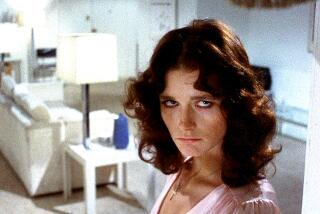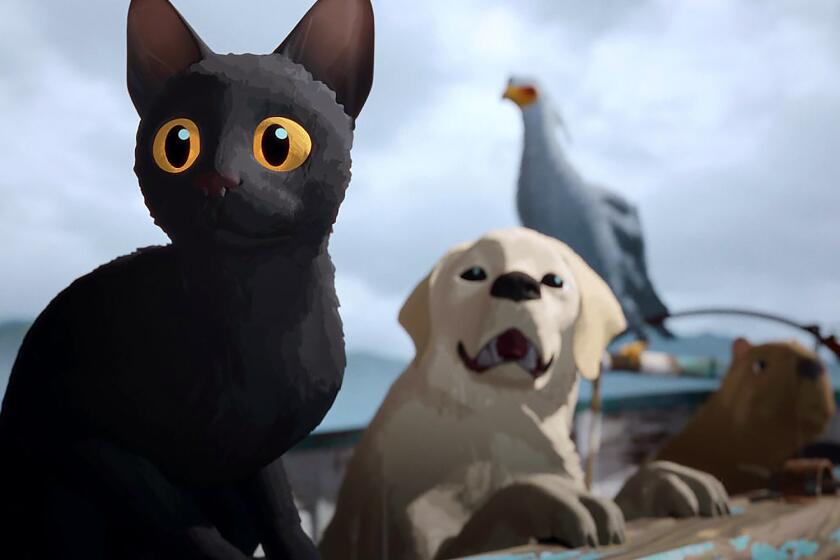Vengeance is theirs
An adrenaline shot to the movie heart, soul and mind, Quentin Tarantino’s “Kill Bill Vol. 2” is a blast of pure pop pleasure. The second half of Tarantino’s long-gestating epic, “Vol. 2” firmly lays to rest the doubts raised by “Vol. 1” as to whether the filmmaker had retained his chops after years of silence and, as important, had anything to offer beyond pyrotechnics and bloodshed. Tarantino does have something to say, although most of what he does have to say can be boiled down to two words: Movies rock.
In a world of commodity filmmaking in which marketing suits offer notes on scripts, this is no small thing. Personal vision is as rare in Hollywood as humility, but personal vision -- old, new, borrowed and true blue to the filmmaker’s inspirations -- shapes “Vol. 2,” giving it texture and density. Personal vision makes Tarantino special, but it isn’t what makes him Quentin Tarantino. What does distinguish him, beyond a noggin full of film references, a candy-coated visual style and a deep-tissue understanding of how pop music has shaped contemporary life, affecting our very rhythms, is his old-time faith in the movies. Few filmmakers love movies as intensely; fewer still have the ability to remind us why we fell for movies in the first place.
The second half of “Kill Bill” opens with Uma Thurman’s avenger, the Bride, recapping her recent deeds (which she aptly touts as a “roaring rampage of revenge”) while driving in front of rear-projected scenery. The setup’s artificiality is our first reminder that we’re still not in Kansas or, for that matter, modern Hollywood. Rather, we’re in Tarantino-wood -- an Elmore Leonard-esque fever dream in which film noir blonds mix it up with Roger Corman super-vixens amid a blur of pulp fiction and pulped flesh. Here, as Jean-Luc Godard (another Tarantino touchstone) once said, blood isn’t blood; it’s red. Which is why here, amid purple and rust-colored desert hills, the lurid neon of the “My-Oh-My Club” (where, needless to say, none of the women look like MOM) and a martial-arts tutorial, the Bride -- and her maker -- can strut their cinematic stuff.
And strut they do. Always a skillful wrangler of actors, Tarantino works wonders with David Carradine as the Bride’s nemesis, the titular Bill; Michael Parks as a repulsive whorehouse pimp; and Hong Kong movie legend Gordon Liu as the Bride’s luxuriously coifed kung-fu master. (Equally memorable is Larry Bishop, whose one-man rant in a wood-paneled office is a classic of managerial sadism.) Carradine’s laid-back cool -- he delivers his lines like a man without a care in the world or, for that matter, a crazy woman on his tail -- permeates the movie, giving it an easygoing vibe. Genre makes a difference too. While “Vol. 1” shares the kinetic energy of blaxploitation and the intensity of Japanese gangster flicks, “Vol. 2” moves to the slower beat of a Sergio Leone western -- with some kung-fu kicks folded in to very entertaining effect.
In “Vol. 1,” the Bride -- whose name we learn in “Vol. 2” is actually Beatrix Kiddo, Beatrix meaning “bringer of happiness” in Latin -- woke from a coma. No ordinary sleeping beauty, the Bride flexed her long toes on waking (Tarantino has a serious foot thing) and shortly thereafter began hacking through her former associates, a killer-elite team called the Deadly Viper Assassination Squad. Lead by Bill, the Deadly Vipers had wiped out the Bride’s wedding party and her plans for the future, incurring her wrath and setting the plot in motion. Equipped with a made-in-Japan samurai sword, she executed two of the Vipers (played by Vivica A. Fox and Lucy Liu) in the first film. Now, in “Vol. 2,” her targets are Elle Driver (Daryl Hannah, summoning up her “Blade Runner” ferocity), Budd (Michael Madsen) and, of course, Bill.
The differences between the two parts of “Kill Bill” are evident from the start. After the Bride’s opening joyride, Tarantino flashes back to the wedding party massacre to set the stage. Like most of “Vol. 2,” this beautifully paced and photographed scene, which cinematographer Robert Richardson shoots in silvery black and sizzling white, plays out with more economy and far less gore than most anything in “Vol. 1.” The improved balance helps explain why, although this half of “Kill Bill” runs about a third longer than the first, it paradoxically feels faster. Crammed with action, “Vol. 1” plays like a greatest-hits mix -- there’s the Pam Grier tribute, the anime chapter and so on. The rhythm feels so off that when the film finally ends it doesn’t come to a well-earned close, it just stops.
It was a mistake to cut “Kill Bill” in half. “Vol. 2” is as great an American movie as we’re likely to see this year, but it’s also, by default and design, incomplete. The film doesn’t suffer too much from the division; unlike “Vol. 1,” it stands fairly steadily on its own. Still, what a missed opportunity. If the first film plays out as a series of self-indulgent climaxes -- little more than bang-bang and Lucy Liu -- the second film showcases Tarantino’s more discreet gifts, like the sight and sound of two people just talking, circling each other with words and innuendo. It’s tantalizing to think what “Kill Bill” might have looked like if the director had cut his footage as ruthlessly as the Bride cuts down her enemies. No doubt the DVD will give us some idea.
The Bride is an iconic character -- the daughter of a thousand wronged women in one tight, sinewy package -- and Thurman gives a suitably iconic performance. This is probably as good as the actress will ever be onscreen, and it’s good enough for the purposes of this film: She looks hot holding a sword, and that’s what counts. Perhaps because the high-domed star and her director look somewhat alike, it becomes all too obvious that Tarantino is engaging in some metaphoric cross-dressing with this character. The Bride isn’t just any conceit; she’s Tarantino’s stand-in, his excuse for slicing and dicing through the last 50 years of exploitation and genre cinema, of bringing his low-end taste together with his high-art aspirations. It’s no wonder that when Bill asks the Bride if it felt good to kill all those people, she nods.
It’s doubtful “Vol. 2” signals an end to the filmmaker’s recycling jones, and it shouldn’t, although having done the ultimate exploitation flick it’s time for Tarantino to move on. Artists as diverse as Gregory Crewdson, who quotes Steven Spielberg movies in his haunting photographs, and OutKast’s Andre 3000, who on his “The Love Below” CD salutes Hendrix and Prince, sample their inspirations freely. This isn’t just a Postmodern tic; it’s a way of making art. Given that the movies are a hybrid medium and filmmakers always steal from one another, generalized complaints about recycling are off point. The larger problem with “Vol. 1” wasn’t pastiche, it was that there wasn’t enough Tarantino in the film to hold together its patchwork of quotations. The filmmaker was so busy topping everyone else he forgot that it’s him we dig.
Watching Tarantino just riff on other people’s movies and squirt fountains of blood in “Vol. 1” was a drag; it cheated the filmmaker of a slam-dunk comeback and us of that rarest of gifts: a movie to love. It also delayed answering the question that’s haunted Tarantino since he became a media sensation or, rather, after the media began to tire of him and his preening: whether he has something to say. That question isn’t often asked of many directors, who can spend entire careers churning out adolescent fantasies and tired genre remixes without attracting the scolding opprobrium that has clung to Tarantino. There’s a distinctly puritan aspect to some of this reproach -- it’s as if some critics felt there was something wrong with a filmmaker taking so much delight in making movies, having, well, so much fun.
In “Kill Bill Vol. 2,” meaning slips into the picture where we least expect it -- right in front of our eyes. Meaning comes from a man smoking a cigarette in a wedding chapel, the cloud of his smoke tracing ominous curlicues in the air. It comes, in the same scene, when the Bride lifts her white veil, a gesture that throws a halo of light around her just moments before everything changes.
Tarantino has been celebrated for his staccato dialogue and pop culture pedantry, but his covert strength is for putting feeling into images, not words. He has a genius for pop iconography, for surfing the highs and vulgar lows of our throwaway culture, and a true grasp of how we find meaning even among the ruins. He taps into our real feelings for the most beautiful of lies.
*
‘Kill Bill Vol. 2’
MPAA rating: R for violence, language and brief drug use.
Times guidelines: Language, kung-fu violence, guns, swords, a poisonous snake and misplaced eyeballs.
Uma Thurman...the Bride / Beatrix Kiddo
David Carradine...Bill
Michael Madsen...Budd
Daryl Hannah...Elle Driver
Gordon Liu...Pai Mei
Michael Parks...Esteban Vihaio
Miramax Films presents a Band Apart, released by Miramax Films. Writer-director Quentin Tarantino. Producer Lawrence Bender. Production designers David Wasco, Cao Jui Ping. Director of photography Robert Richardson. Editor Sally Menke. Original music the RZA, Robert Rodriguez. Martial arts advisor Yuen Woo-ping. Casting Joanna Ray. In English and Mandarin, Cantonese and Spanish with English subtitles. Running time: 2 hours, 10 minutes.
In general release.
More to Read
Only good movies
Get the Indie Focus newsletter, Mark Olsen's weekly guide to the world of cinema.
You may occasionally receive promotional content from the Los Angeles Times.










